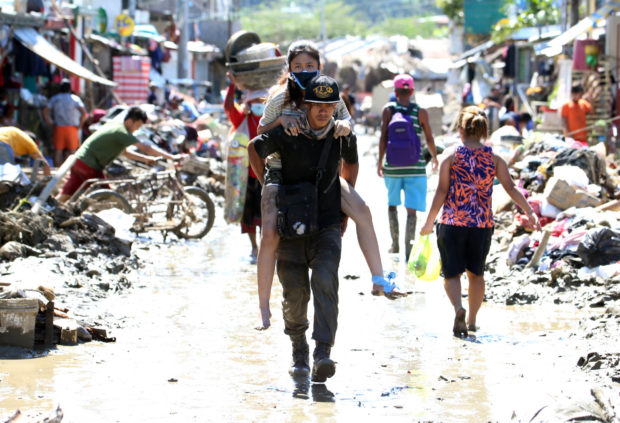By the Inquirer Staff /November 19, 2020
President Rodrigo Duterte has placed the entire island of Luzon under a state of calamity to enable the national and local governments deal faster with widespread devastation caused by three successive typhoons and respond quickly to pleas for help from residents whose lives have been upended by the disaster.
In a televised address on Tuesday night, Duterte said he signed the proclamation on Monday night.
Malacañang, however, has yet to release the text of the proclamation.
But presidential spokesperson Harry Roque said in a television interview on Wednesday that there would be a freeze on the prices of basic commodities, especially food.
The proclamation will also allow local governments to spend their calamity funds without restrictions, he said.
“[Places] under a state of calamity will become the area of top priority for all agencies in the provision of necessary relief goods and, of course, the task of rehabilitation,” Roque said.
Typhoons “Quinta” (international name: Molave) and “Rolly” (Goni) struck Luzon in late October and early November, and “Ulysses” (Vamco) swept across the island last week, worsening the damage to the provinces ravaged by the two earlier storms.
The three typhoons overfilled dams in the region, some of which spilled water to prevent catastrophic breaches. The spillage, however, worsened flooding in Metro Manila, Bulacan, Pangasinan, Benguet, Cagayan, Isabela, Rizal and other provinces in Luzon caused by Quinta and Rolly.
Ulysses blew across the island overnight on Nov. 12, topping Magat Dam in Isabela province, forcing the operators to open the spill gates to release water and save the dam from bursting.
The dam held, but the spilled water ran into rivers in the region, which topped their banks and inundated swaths of Isabela and nearby Cagayan in what officials called the worst flooding they had seen in more than 40 years.
Lawmakers from both the Senate and the House of Representatives are looking into the flooding.
On Wednesday, the House agriculture and food committee, acting on a resolution filed by Speaker Lord Allan Velasco, Majority Leader
Martin Romualdez, and Minority Leader Joseph Stephen Paduano on Tuesday, set a hearing on the flooding in Isabela and Cagayan for Nov. 24.
The committee will summon local officials from the two provinces, as well as officials of the National Irrigation Administration (NIA), who will be questioned about the release of water from Magat Dam at the height of Ulysses.
Guidelines followed
“Just to be fair to all as well, it would be very hard also to realize that maybe true enough, the NIA did their part, they were responsible enough in following their protocols, maybe the local government officials did not get the proper warnings. We will find out everything from this hearing,” Quezon Rep. Mark Enverga, the committee chair, said.
NIA chief Ricardo Visaya said he was open to any investigation into the release of water from the dam. Speaking at a news briefing on Tuesday, Visaya said the NIA had always been following guidelines dating back to 2006 that allow release of water from the dam on recommendation of the state weather service Philippine Atmospheric, Geophysical and Astronomical Services Administration (Pagasa).
“Pagasa will tell us that we are in a preemptive level so we have to release water, and that is about two to three days . . . before the arrival of the typhoon,” Visaya said.
He said the NIA sent written communication to local officials about the water release on Nov. 8, but “it’s as if our fellow countrymen did not believe it.”
Damage rises
Nevertheless, he said, the NIA, together with Pagasa, Department of the Interior and Local Government, National Power Corp. and National Disaster Risk Reduction and Management Council, was reviewing the guidelines
On Wednesday, the Department of Agriculture said the combined damage to crops and farms caused by the three typhoons had risen to P12.3 billion.
Quinta and Rolly had caused damage and losses amounting to P8.46 billion and Ulysses P3.84 billion, the department said.
The agency’s disaster council said 211,273 farmers and fishermen suffered losses, 325,676 hectares of farmland were damaged and 487,438 metric tons of produce destroyed.
Ravaged by the three typhoons were Bicol, Calabarzon, Cordillera Administrative Region, Ilocos, Cagayan Valley, Central Luzon, Mimaropa, Western Visayas, Eastern Visayas and Zamboanga Peninsula.
In Bicol alone, Ulysses caused P2 billion in damage to agriculture and infrastructure, the Office of Civil Defense in the region said on Wednesday.
Gremil Alexis Naz, spokesperson for the regional office of the agency, said damage to crops, fisheries, and livestock reached P128 million, with the province of Camarines Norte losing P82.2 million; Camarines Sur, P38.5 million; Albay, P1.9 million; and Sorsogon, P308 million.
Infra damage
The Department of Public Works and Highways office in the region reported P1.9 billion in damage to national roads and P495 million to bridges. It also recorded P334 million in damage to flood control facilities and P1.1 billion to government buildings and infrastructure.
—Reports from Jerome Aning, Karl R. Ocampo, Julie M. Aurelio and Mar S. Arguelles




